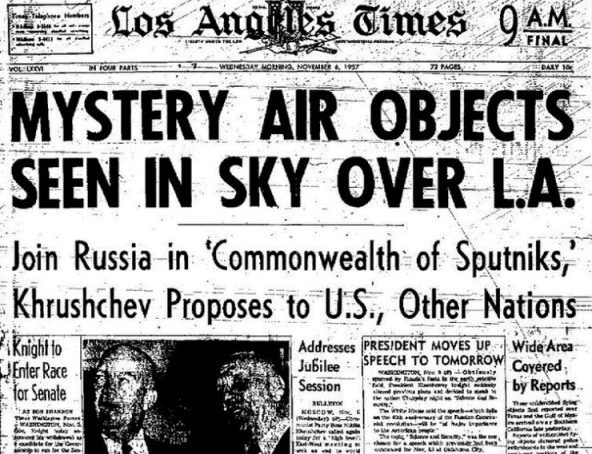
Even just a few decades ago, you would have been laughed out of the room for suggesting that something could be in more than one place at a time, or that anything could operate at speeds faster than light, that the universe is going to expand forever, that light could be slowed down and twisted in knots, and that dark matter might be an entirely different form of matter which interacts with nothing at all except gravity.
To reach those findings, scientists and engineers first explored an anomaly—for example, the movement of galaxies being inexplicable if ordinary matter was all you could feed into the equations—and discovered whole new areas of knowledge.
It’s very much the same for the “science of UFOs.” That’s not a contradiction in terms nor a new oxymoron, but a phrase we should all start using more often.
So, let’s start with some facts about the anomaly:
- UFOs are real. They are exactly what they say they are—unidentified flying (or swimming) objects and there have almost certainly been over two million sightings of such objects since the turn of this century.
- We know that the vast majority of sightings are almost certainly mistakes and misidentifications of natural things.
- There are upwards of 150,000 observations of such things every year across the globe.
- Government research—across several nations—shows that a consistent fraction of these prove to be totally inexplicable in terms of our existing scientific and technological understanding.
- Despite seventy years of ridicule, the reports show no sign of diminishing and disappearing.
- They keep flowing in. Even the US Department of Defense has recently released some pretty compelling evidence of very strange things in the sky.
- There are probably around 6,000 credible, inexplicable observations every year.
- All this amounts to a very strong a priori case for the existence of a serious scientific anomaly in terms of numbers of inexplicable observations, the span of time over which observations have been made, the immense geographical extent, and the core of credible evidence from trained observers.
It’s also worth noting that, in contrast to the commonly accepted view of the subject being the sole domain of geeks and weirdos, it has always been the focus of scientific and technological investigation (albeit insufficient in number and restricted in scope). Governments have always taken them seriously (behind closed doors); those who study them have included extremely competent scientists, engineers, and researchers, and, private organisations are now mounting small but determined scientific efforts to get to the bottom of the phenomena.
Government UFO Science
Between about 1940 and 1947 the US and British governments were the unwilling recipients of weird news. First, there was a steady stream of reports from wartime aircrews that their fighters and bombers were being shadowed by strange lights and objects. The Americans christened them “foo-fighters” and the name stuck. Then, in the years between 1945 and 1947 there were hundreds of reports of lights and objects being seen across the USA. In Britain, radar picked up things over the North Sea flying very fast and high—too fast and too high for the aircraft of the time. In Scandinavia people saw large numbers of what they called “ghost rockets.”
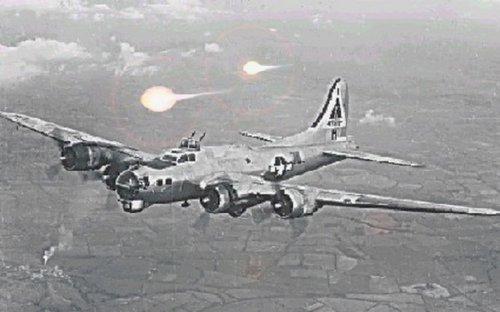
The term foo fighter was used by Allied aircraft pilots in World War II to describe various UFOs or mysterious aerial phenomena seen in the skies over both the European and Pacific theaters of operations. Formally reported from November 1944 onwards, witnesses often assumed that the foo fighters were secret weapons employed by the enemy. The Robertson Panel explored possible explanations, for instance that they were electrostatic phenomena similar to St. Elmo’s fire, electromagnetic phenomena, or simply reflections of light from ice crystals.
The initial assumption was that all these events and sightings were the result of rapid Soviet technological advances stimulated by captured German scientists. The fact that the Americans and British had also corralled a good few German geniuses—and that they had not delivered such stunning technologies—was somewhat ignored.
In fear of having been outpaced in the technological race, both the Americans and the British set up serious studies of the “flying saucer” phenomenon. The US Air Force kept a beady eye on the subject through its superficial, on-off research in Projects Sign, Grudge, and Blue Book. In the UK there was the post war Flying Saucer Working Party and the collection of data by the Ministry of Defence right through to 2009.
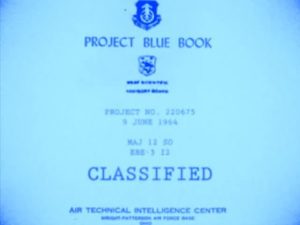
Project Blue Book was one of a series of systematic studies of unidentified flying objects conducted by the United States Air Force.
These were data collection exercises, not scientific studies, but it would be very wrong to believe that governments did not also try to gather scientific data and assess the issue in scientific and technological terms. The very first known attempt to undertake primary research on UFOs was the cutely-named Project Twinkle. That year-long study in 1950-51, was run by LandAir Inc. —now part of DynCorp. It used cine-theodolites, spectrographic cameras, and radio spectrum analysis at a number of listening and watching posts over wide area of the far west. The official summation was that it had failed, but there is evidence from Dr. Bruce Maccabee that it did succeed in spotting objects at immense altitudes on one occasion. In a paper now located in the National Archives, Dr. Anthony Mirarchi—the first head of Twinkle—said that 30-foot objects had been spotted some 150,000 feet over Holloman AFB on April 27 1950. What those objects were has never been explained.
The US official studies that followed—Robertson (1953) and Condon (1968) —were reviews of existing UFO cases. They were conducted by scientists and engineers, but were limited to re-assessment of secondary evidence. There is also evidence that they were “encouraged” to arrive at certain, negative conclusions. In the UK, Dr. David Clarke uncovered a hitherto-secret UK government scientific study of the phenomenon, conducted in the years up to the end of the last century. Like the US reports before it, the UK Condign Report of 2000 is extremely flawed, but it did look into a lot of possible scientific explanations for UFOs including plasmas and other, as-yet little understood, atmospheric phenomena.
And, of course, we now know that a more recent scientific study has been carried out in the US in the form of the five-year Advanced Aviation Threat Investigation Program (AATIP), whose final report from 2012 is still not available to the public. The recent Department of Defense videos of US Navy observations came from that study. Luis Elizondo, who headed up AATIP, has since gone on record saying that the programme came to the conclusion that some very advanced technologies were probably involved in the phenomenon—including space-time warping and the manipulation (in some as yet unknown way) of gravity and inertia.
Weird Science
Over the last seventy years, our comfortable, mechanical view of the universe has been destroyed. Like an old telephone exchange whose miles of wires and switchboards have been ripped out and replaced by solid-state systems linked together by WiFi, the old world of science is being demolished theory by theory. The Newtonian Universe is dead, long live the Einsteinian version.
Precisely what will replace the old Newtonian paradigm has yet to be fully understood, but the building blocks have been falling into place over the past century. The new universe is looking very, very strange, and our new knowledge and advanced theories mean that some of the accepted “truths” which made us doubt UFOs in the past are now at least possible. For example, we now suspect that moving faster than the speed of light may be entirely feasible, just as aerospace companies are finding that there are ways to travel faster than the speed of sound without causing sonic booms.
At Berkeley, Professor Yasunori Nomura is producing compelling mathematical reasons to believe that we may not be living in a single universe, governed by implacable laws, but in “probability space” where nothing is certain or entirely predictable, except in terms of probability. Possibly connected to these findings, Harvard Professor Lisa Randall postulates that most of the universe, in the form of dark matter, is not interacting with the electromagnetic spectrum nor with normal matter, but through gravity. The increasingly weird nature of the universe is not explaining UFOs yet, but it is certainly expanding the areas of debate.
Private UFO Science
A seismic shift is underway. For the past seventy years the private sector has focused on filling databases with largely ambiguous, vague, and unscientific reports (and governments have done the same). The process has been painful, but it incredibly helpful in evidencing the persistence of the anomaly and the credibility of some observations.
The same seismic shift is prompting private organisations to actively seek primary scientific information. Whether the data support or undermine any particular theory of what UFOs are does not matter. The object is to acquire replicable primary scientific information on the phenomenon and to use that to attempt to identify what is causing it. Today, a number of groups across the world are openly studying the UFO phenomenon, and we can be pretty sure that several governments will also be doing so (but perhaps less openly).
Dr. Richard Haines’s National Aviation Reporting Center on Anomalous Phenomena (NARCAP) takes a very scientific approach to mainly aviation-centered reports. Its data are mainly secondary (witness reports and sometimes primary radar data) but the investigations are professional and thorough. NARCAP currently works with overseas organisations in Chile (CEFAA) and France (3AF Sigma 2).
UFOData, led by Dr. Mark Rodeghier and Dr. Alexander Wendt, is aiming to build a large network of automated surveillance stations with sophisticated sensors. Their stations will have a core optical unit for images and spectra, a magnetic sensing unit, instrumentation to detect microwave and other radiation, and other sensors to record atmospheric and local environmental data
Francis Ridge’s National Investigations Committee on Aerial Phenomena (NICAP) offers individuals the chance to help. The $180 MADAR III system, designed primarily to detect electromagnetic changes in the surrounding area, can be purchased and set up by anyone interested in the subject. (MADAR stands for Multiple Anomaly Detection and Automatic Recording.)
In France, an outfit called UFO-Science is led by Jean-Pierre Petit, a retired astrophysicist at the French National Centre for Scientific Research (CNRS) in Marseilles. UFO-Science approaches the issue from a slightly narrower angle. It sells spectral analysis covers and diffraction gratings for people to use and report findings.
In the valley of the river Hesja in Norway a small group of scientists and engineers has been studying the anomaly with ever more sophisticated instrumentation since the 1980s. Dr. Erling P. Strand’s Hessdalen group uses high quality equipment to automatically record sightings of strange lights and objects. Linked still and movie cameras aided by magnetometers take what are termed “alarm photos” when two of them identify a strange light in the frame. The group has a new purpose-built station on Mount Skarven.
And, of course, there is the To the Stars Academy in the US, which is using crowd-sourcing to raise millions to sponsor scientific research into UFOs. Its senior people include ex-government officials and senior scientists such as Luis Elizondo, Dr. Hal Puthoff, and Christopher Mellon. It was this group that recently released the incredibly compelling US military sensor evidence recorded by US fighter aircraft between 2004 and 2017. The 2004 event was tracked by US Navy warships and several US Navy aircraft including an F-18 piloted by Commander David Fravor. He gave an interview last year in which he described a white oblong object, moving erratically. He said it had “the ability to hover over the water, and then start a vertical climb, from basically zero up towards about 12,000 feet, and then accelerate in less than two seconds, and disappear.” His visual sighting was supported by highly capable sensor data from his aircraft.
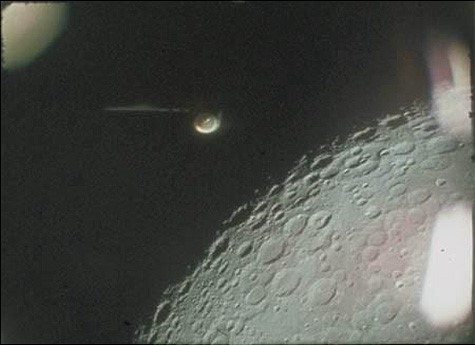
Beginning their return from the moon to an April 27, 1972, splashdown, Astronauts John Young, Thomas Mattingly, and Charles Duke captured about four seconds of video footage of an object that seemed to look a lot like Hollywood’s version of a spacecraft from another world. The image above is a high-resolution, digital scan of a full frame from the original Apollo 16 film showing the object in question (top center) and its position relative to the moon. Reflections in the window are also visible (left and right). All of the evidence in this analysis is consistent with the conclusion that the object in the Apollo 16 film was the EVA [spacewalk] floodlight/boom. Image courtesy of NASA.
After seventy years of “modern” observations we still have no clear idea what UFOs are, but it’s about time we started investigating the phenomenon properly and that means a long-term, well-funded scientific study on a global basis.
About the Author
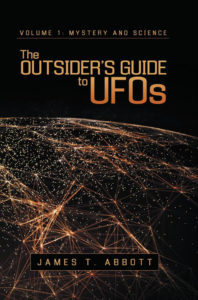 Following a short scholarship to Trinity College in Hartford, Connecticut, James T. Abbott completed a bachelor’s degree in politics and economics at the University of York, England and later researched a master’s thesis at the University of Cambridge on global trade in the aerospace industry. His career has encompassed time in the aerospace sector, in marketing, in education and in commercial research. He’s written and contributed to around a dozen academic books on political theory, business, and several editions on applied economics, and countless lengthy reports including a good few on the aerospace industry. His greatest professional love is research, which is at the basis of his book, The Outsider’s Guide to UFOs: Volume 1 — Mystery and Science. He currently serves as a member of the Market Research Society, the Chartered Institute for Human Resources, and British Interplanetary Institute and lives with his wife in Yorkshire, England.
Following a short scholarship to Trinity College in Hartford, Connecticut, James T. Abbott completed a bachelor’s degree in politics and economics at the University of York, England and later researched a master’s thesis at the University of Cambridge on global trade in the aerospace industry. His career has encompassed time in the aerospace sector, in marketing, in education and in commercial research. He’s written and contributed to around a dozen academic books on political theory, business, and several editions on applied economics, and countless lengthy reports including a good few on the aerospace industry. His greatest professional love is research, which is at the basis of his book, The Outsider’s Guide to UFOs: Volume 1 — Mystery and Science. He currently serves as a member of the Market Research Society, the Chartered Institute for Human Resources, and British Interplanetary Institute and lives with his wife in Yorkshire, England.
The Outsiders Guide to UFOs explains why there may be up to 3,000 inexplicable UFO sightings every year around the world. The book also presents four compelling theories about UFOs, clarifies the background, simplifies the main questions, and presents evidence and counter-evidence about the mysterious things we see in the sky. More importantly, it recommends straightforward action to settle the UFO question once and for all.


